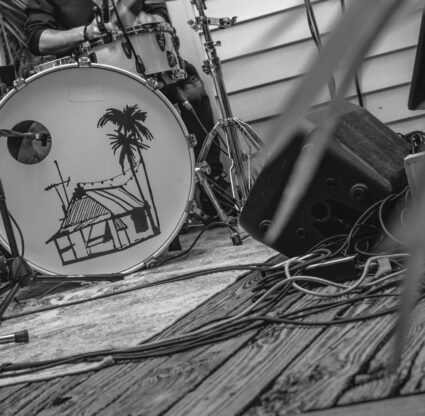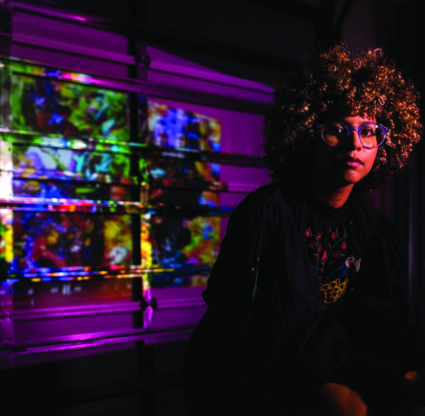As soon as she discovered how to write, Lyn Millner could be found tracing the footsteps of anyone and everyone, notebook in hand.
Her older brother’s inventions and wrongdoings were endlessly fascinating; babysitter behaviors were penned behind lock and key; no dog spotted in her Jackson, Mississippi, neighborhood was safe. She wrote down recipes, newsletters, adventure stories, all in a handwriting crooked from her struggle to settle on which hand to use. (She eventually chose the left.)
“When I read Harriet the Spy by Louise Fitzhugh, I knew that there were other little girls who did that,” Millner says, everything about her still youthful at 48. “At least, in that fictional world there were other little girls who did that.”
Today, Millner has traded diaries for computers and ditched “writin’ sticks” in favor of her own furiously typing fingers. With a master’s in creative nonfiction from Florida International University, she’s written for NPR, USA Today, myriad magazines. She founded the journalism program at FGCU, where she remains a notoriously challenging associate professor, and headed the department for seven years. But most recently, her focus has turned from the wide world in front of her to a mysterious group of the past. For the last five years she’s traced the footsteps of the Koreshan Unity, putting together a book about the lost utopia in Estero once led by powerful orator Cyrus Teed.
The story is fantastic enough to captivate anyone: “Doctor of Eclectic Medicine” Teed claimed that he turned lead into gold, at which point an angel appeared and told him he was destined to save all of humanity; claimed that Earth is hollow, the continents lining its inside, and encapsulates the entire universe; claimed that if his followers remained celibate and directed their energy instead as devotion toward him, the Messiah, they would become immortal upon his death when he and the angel merged into a mother-father god.
“So when his pineal gland exploded—” Millner snorts, “sorry, I’m just the reporter—that would allow him to dissolve, and he would enter into her divine receptacle. Take that as you will.”
But Millner’s curiosity couldn’t end with the raising of an eyebrow or shake of the head.
 Hours upon hours she spent sifting through history, toes ever-flexing beneath a desk of scribbled-on papers, sometimes the kitchen table, uncovering the madness—and perfect normalcy—of the cult that once lay in our own backyard. She’d become so immersed she’d graduate from single lenses to bifocals, mix up Teed’s birthday with her wedding anniversary, dream about meeting him over buffet-line black-eyed peas. On Oct. 20 (“two days after Teed’s birthday, which he will be very happy about”), her own devotion will debut in the form of narrative nonfiction: The Allure of Immortality: An American Cult, a Florida Swamp, and a Renegade Prophet, published by the University Press of Florida.
Hours upon hours she spent sifting through history, toes ever-flexing beneath a desk of scribbled-on papers, sometimes the kitchen table, uncovering the madness—and perfect normalcy—of the cult that once lay in our own backyard. She’d become so immersed she’d graduate from single lenses to bifocals, mix up Teed’s birthday with her wedding anniversary, dream about meeting him over buffet-line black-eyed peas. On Oct. 20 (“two days after Teed’s birthday, which he will be very happy about”), her own devotion will debut in the form of narrative nonfiction: The Allure of Immortality: An American Cult, a Florida Swamp, and a Renegade Prophet, published by the University Press of Florida.
“Everything Lyn does is super-sized,” says her husband, Jesse Millner, a poet and also a professor at FGCU. “When it’s something she wants to do, it’s all-consuming. She works really, really hard, and she gets the idea that writers are supposed to sit in a chair and write, and she does that.”
*
It’s a hot may afternoon at Koreshan State Historic Site. Few Southwest Florida natives seem to know the saga behind the land off U.S. 41 and Corkscrew Road, but its buildings bear plenty of Millner’s nose prints.
In the early 1900s, she says, it would be teeming. The handful of Koreshans who moved from Chicago to their Florida frontier in 1894 grew to more than 200, establishing a printing press, bakery, general store, hostelry, boat works, cement works and sawmill. They grew their own citrus, had their own livestock, made their own lace. They did successful business with a judgmental outside community. They formed an orchestra and put on their own plays.
“This is going to sound crazy, but I don’t think that they were crazy,” Millner says.
Pacing the palm- and oak-lined property, she muses how the breeze would have blown through the houses, how suspicious it was when the printing press burned down. She floats between matter-of-fact mastery of the subject and wide-eyed enthusiasm, rattling off names, dates and backstories as if she had lived them herself.
Victoria Gratia was Teed’s “main squeeze,” the one he considered his equal—the angel in the flesh with whom he would combine upon his death. She ran off with the dentist when Teed died. Millner portrayed her in a historic site “ghost walk.”
Believer and benefactor Henry Silverfriend would let Teed put things like the printing press in his name for when the creditors came calling—despite many ladies taking their family money when they left their husbands to follow him, Teed never could pay the bills.
Teenage Vesta Newcomb quickly became one of Teed’s darlings and lasted the longest of any original follower. She remained loyal even when his dead body blackened as a mere mortal’s in his custom-made bathtub, but stopped believing when man landed on the moon.
Virginia Andrews, Millner’s “favorite character,” joined because her beloved husband believed and she didn’t want to break up her family, but she later became one of the unity’s leading women.
“I really wanted to do DNA testing on any hair we could find in her combs,” Millner says. “I didn’t find any.”
“These people are real to her,” says Melissa VandeBurgt, FGCU’s archive special collection and digital initiative librarian, who recently curated an exhibit titled The Koreshans at the school. “She knows them because she spent five years living and breathing them.”
When you devour every detail as a piece to the puzzle, where do you begin? After working angle after angle, Millner asked a fiction writer friend from grad school “who’s really, really, really good at plot” for advice. He had a nonnegotiable opinion on the perfect way to start. As for the all-important title, “the publisher does that, thank God.”
The rest of her process is quite mathematical. Very “workman-like,” she says. Keeping rigid appointments with herself, she prefers to single out stars in the storyline, map out a framework and write to her own instruction.
“Even though it’s nonfiction, you think about it like, OK, when Cyrus Teed has an angel appear to him, that’s a pretty big plot point,” she says. “So you want to give that a good amount of page time, and you want to make it a scene as opposed to just narrating it, ‘And then an angel appeared to Cyrus Teed, and then he was working in his lab.’ No.”
From there, it’s “research, research, research.”
“I loved that part,” she says. Her journalist is showing. “There were times when I just didn’t feel like writing, but I always felt like researching because I knew I was going to find something amazing.”
*
Millner couldn’t wait to edit her first draft; it’s always pure pleasure to go back and fiddle. An addiction, actually.
“I don’t know that I’m going to read a 368-page book backward,” Millner says, back in May. Typically, she proofs even 2,000-word articles sentence by sentence in reverse. “I don’t think I’ll do that. Some of the rules don’t apply, I’m finding out as I go along.”
This is her first book that hasn’t wound up in a drawer, she shares. She first pitched the story to the Oxford American, but ultimately it wasn’t published.
 “I thought, ‘Great.’ But that was OK because I realized it needed to be a book,” she says. “So I kept working on it and really worked on it in isolation not really knowing if anyone would be interested. By then I had kind of been pulled in by Cyrus Teed. My husband jokes that I was yet another wife who had been stolen.”
“I thought, ‘Great.’ But that was OK because I realized it needed to be a book,” she says. “So I kept working on it and really worked on it in isolation not really knowing if anyone would be interested. By then I had kind of been pulled in by Cyrus Teed. My husband jokes that I was yet another wife who had been stolen.”
When writing it all down, she would break only long enough to recharge with a workout or grab a peanut butter jar and spoon. Brackets went around weak parts that needed fleshing out so she could search the document for them later. She had to strike when the iron was hot—even if it meant hiding from family “asleep” in the dark.
All her subjects may have been dead, but they left behind a historical writer’s gold mine: depositions from court cases with angry Chicago husbands and Fort Myers neighbors; newspaper articles by wildly entertaining journalists; photographs revealing stature and telling side glances; meeting minutes; land deeds; self-promotional materials; menus; invitations; letters; journals; descendants.
Predictably, Millner kept everything organized. (“I can load a dishwasher like nobody’s business,” she adds.) Her accounting skills in particular came in handy—she earned a bachelor’s from Georgia State University before she answered her true calling—in the form of a Microsoft Excel spreadsheet. Seven-hundred-some articles neatly sorted by name and number. Each exciting discovery had led to another. And another.
“Sometimes I’d hear her yell in her office,” Jesse Millner says. “I’d hear like a ‘Whoopee!’ kind of thing and I’d think, ‘What?’”
Voluminous handwritten letters from Teed, dug up in Tallahassee archives, brought him to life. Sometimes his outpourings were nonsense. Sometimes they were mundanely human, like when he wrote to his sister saying the sleeves on the shirt she had sewn him were too short.
“I could see how hard he pressed on his pen to the page to emphasize certain things,” Lyn says. You can tell she feels privileged.
She spoke to a medical examiner about the skin marbling that appeared on Teed’s body five days beyond his death—interpreted by his vigilant followers as “hieroglyphics” evident of his return.
She found a neurologist who would tell her if his death could indeed be attributed to when he was beaten up in Fort Myers two years prior, as was widely believed. (Highly unlikely, the neurologist says, but Millner likes to think the spectacles on display in the art hall were the very ones knocked from his face.)
She reached out to a wildlife expert to see if the black bear in a photograph could in fact be the bear described as being trapped on Fort Myers Beach, named “Teddy” (after Roosevelt) and put in a pit. The expert revealed it could have been—and that he was snapped watching someone walk by.
“I’m like, ‘Oh my God, it’s real! They were really here!’” Millner says. Goose-bump moments like that gave her renewed purpose, but many didn’t wind up in the book. But the one that topped them all became the ending to her story.
 Reading a Chicago Herald issue from 1886, Millner learned that Teed’s big breakthrough in acceptance, at a mental science convention, took place at a church-turned-lecture hall with a candy factory operating out of the basement. From there, she searched Google for “history of Chicago candy”; turned up an exhibit titled Sweet Home Chicago; contacted the curator for the factory on the corner of Washington and Sangamon in 1886; heard back it was Berry’s Confectionery (with a photo!); found a Berry’s newspaper ad listing Klondike brittle, peanut brittle, rose cream almonds; asked a chef which would permeate strongest up to the lecture hall. Caramel and the rose creams. Millner wove the detail into her one scene—oh, how hard it was to concentrate with the sugary smells wafting from below—and moved on.
Reading a Chicago Herald issue from 1886, Millner learned that Teed’s big breakthrough in acceptance, at a mental science convention, took place at a church-turned-lecture hall with a candy factory operating out of the basement. From there, she searched Google for “history of Chicago candy”; turned up an exhibit titled Sweet Home Chicago; contacted the curator for the factory on the corner of Washington and Sangamon in 1886; heard back it was Berry’s Confectionery (with a photo!); found a Berry’s newspaper ad listing Klondike brittle, peanut brittle, rose cream almonds; asked a chef which would permeate strongest up to the lecture hall. Caramel and the rose creams. Millner wove the detail into her one scene—oh, how hard it was to concentrate with the sugary smells wafting from below—and moved on.
Two years later, Millner was at FGCU for the arrival of books donated to The Koreshans exhibit.
“You would have thought she was a 5-year-old waiting for an ice cream cone,” VandeBurgt says. She explained to a bouncing Millner that the process would be slow, as she had to examine the books for stability and mold. The easiest way to do that? Smell them. Eventually, VandeBurgt pulled out a cool old Bible.
“I said, ‘That looks like Teed’s Bible…. What’s the copyright?’” Millner says. “She opens it up, and she goes, ‘What is this smell?’”
Millner leaned over and inhaled. It was caramel, almond and rose. Like magic.
*
The koreshans will always be a part of Millner, she says. But the wheels are already turning for her next project, her nose in 12 books and several ideas on a whiteboard in her home. Writing is a way of life.
“Yeah, totally. You can’t not write,” she says. “That was grammatically elegant, wasn’t it?”
Until her next book, look for more from her—er, Teed—on Twitter. She just can’t resist.
“He’s not really great at Twitter because he was very, very longwinded,” she says. “But he, you know. He tries his best.”





